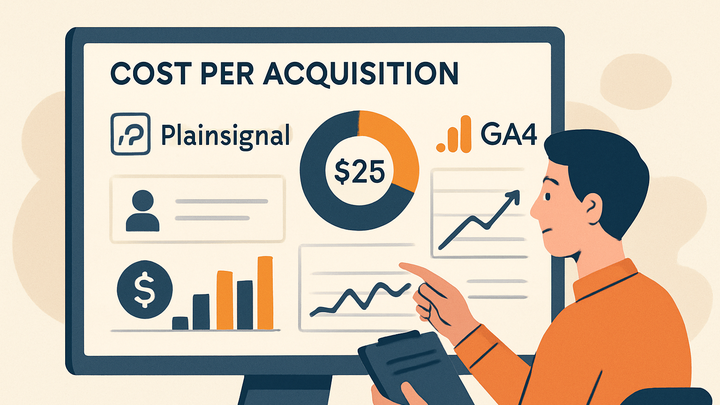Published on 2025-06-22T02:24:56Z
What is Cost Per Acquisition (CPA)? Examples and Usage
Cost Per Acquisition (CPA) is a key performance indicator in digital analytics that measures how much you spend on marketing to acquire a single customer or conversion. It helps marketers and analysts understand the efficiency of campaigns by dividing total costs by the number of acquisitions. By tracking CPA, businesses can allocate budgets toward the most cost-effective channels and fine-tune their strategies. CPA is widely used alongside other metrics like ROI and CLV to paint a complete picture of campaign performance. In cookie-free environments, modern tools like PlainSignal enable CPA tracking without relying on third-party cookies, while platforms like Google Analytics 4 (GA4) offer robust conversion and cost-import features. Understanding CPA calculation, implementation, and optimization is essential for maximizing marketing ROI.
Cost per acquisition (cpa)
CPA measures marketing spend per customer or conversion to assess campaign efficiency and optimize budgets.
Definition and Significance
This section introduces CPA, explains its core components, and highlights why it’s a foundational metric for performance marketing.
-
Definition of cpa
Cost Per Acquisition (CPA) is the average cost incurred to acquire one paying customer or conversion event. It is the ratio of total marketing spend to the number of acquisitions during a given period.
-
Acquisition types
May include purchases, form submissions, sign-ups, or any predefined conversion event.
-
Cost components
Encompasses ad spend, creative production, platform fees, and related marketing expenses.
-
-
Why cpa matters
CPA reveals the true expense of driving conversions, allowing teams to compare channel efficiency, set realistic budgets, and forecast return on ad spend (ROAS).
Calculating CPA
Learn the standard formula for CPA and see a practical example illustrating how to compute it for real-world campaigns.
-
Basic formula
CPA = Total Cost / Number of Acquisitions
-
Total cost
Sum of all marketing expenditures across channels, including ads, creative, and fees.
-
Number of acquisitions
Total count of completed conversion events (e.g., purchases or sign-ups).
-
-
Practical example
If you spend \(2,000 on ads and acquire 50 customers, CPA = \)2,000 / 50 = $40. This benchmark helps you compare performance across channels.
-
Spend breakdown
Allocate costs by channel to calculate channel-specific CPA.
-
Channel comparison
Identify which channels yield the lowest CPA and prioritize budget accordingly.
-
Tracking CPA with Analytics Tools
Explore how to implement CPA tracking in both cookie-free and traditional analytics platforms, using PlainSignal and Google Analytics 4 as examples.
-
PlainSignal (cookie-free analytics)
To track CPA in PlainSignal, insert the lightweight tracking snippet on your site and define conversion goals. Then import or sync cost data for automatic CPA calculations.
<link rel="preconnect" href="//eu.plainsignal.com/" crossorigin /> <script defer data-do="yourwebsitedomain.com" data-id="0GQV1xmtzQQ" data-api="//eu.plainsignal.com" src="//cdn.plainsignal.com/plainsignal-min.js"></script>Once installed, configure goals in the PlainSignal dashboard and upload cost data via CSV or API for full CPA reporting.
-
Goal setup
Define acquisition events (e.g.,
purchase,signup) in the PlainSignal interface to track conversions. -
Cost data import
Upload ad spend reports or connect via API so PlainSignal can compute CPA automatically.
-
-
Google analytics 4
GA4 calculates CPA by marking events as conversions and importing cost data from linked ad accounts.
Steps:
- Install the GA4 gtag snippet on your site.
- Configure
purchaseor other events as conversions in the GA4 UI. - Link Google Ads or other ad platforms to import spend data.
- Use GA4 Explorations to divide total cost by conversion count.
-
Define conversion events
Mark key events like
purchaseorform_submitas conversions under Configure > Events. -
Link ad platforms
Connect Google Ads to GA4 to automatically import cost metrics.
-
Use explorations
Build a custom report that divides imported cost by the number of recorded conversions.
Best Practices for Optimizing CPA
Reducing CPA involves smarter targeting, bid management, and optimizing user experience. Apply these strategies to improve campaign efficiency.
-
Segment campaigns
Break out campaigns by audience demographics, geography, or channel to pinpoint high-performing segments and allocate budget effectively.
-
Demographic targeting
Adjust bids or budgets for age, gender, or interest groups that convert best.
-
Channel-specific budgets
Allocate spend to channels with the lowest CPA based on historical data.
-
-
Refine bidding strategies
Leverage automated bidding (e.g., Target CPA in Google Ads) or manually adjust bids to balance cost and volume of acquisitions.
-
Maximize conversions
Use platform algorithms to get the most conversions within your budget.
-
Target cpa bidding
Set a target CPA and let the system optimize bids to achieve that goal over time.
-
-
Optimize landing pages
Ensure landing pages match ad messaging, load quickly, and feature clear calls to action to boost conversion rates and lower CPA.
-
A/b testing
Compare different headlines, CTAs, and layouts to find the highest-converting variants.
-
Page load speed
Minimize load times by compressing images and leveraging caching to reduce bounce rates.
-
